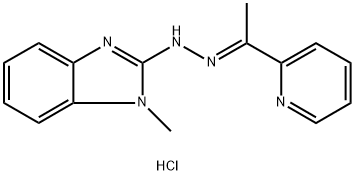1992052-49-9
 1992052-49-9 結(jié)構(gòu)式
1992052-49-9 結(jié)構(gòu)式
基本信息
化合物 T12906
1-甲基-2-(2-(1-(吡啶-2-基)亞乙基)肼基)-1H-苯并[D]咪唑鹽酸鹽
EPH 116 hydrochloride
1-Methyl-2-(2-(1-(pyridin-2-yl)ethylidene)hydrazineyl)-1H-benzo[d]imidazole hydrochloride
| 報(bào)價(jià)日期 | 產(chǎn)品編號(hào) | 產(chǎn)品名稱 | CAS號(hào) | 包裝 | 價(jià)格 |
| 2025/02/08 | HY-101447A | SI-2 hydrochloride | 1992052-49-9 | 1 mg | 500元 |
| 2025/02/08 | HY-101447A | SI-2 Hydrochloride SI-2 hydrochloride | 1992052-49-9 | 5mg | 1100元 |
| 2025/02/08 | HY-101447A | SI-2 Hydrochloride SI-2 hydrochloride | 1992052-49-9 | 10 mM * 1 mLin DMSO | 1210元 |
常見問題列表
IC50:3-20 nM (breast cancer cell death).
SI-2 selectively reduce the transcriptional activities and the protein concentrations of SRC-3 in cells through direct physical interactions with SRC-3.
SI-2 selectively induces breast cancer cell death with IC
50
values in the low nanomolar range (3-20 nM), but not affect normal cell viability.
SI-2 (100 nM) decreases cell motility, invasion, and tumor metastasis in MDAMB-468 cells.
Cell Viability Assay.
| Cell Line: | MDA-MB-468 cells. |
| Concentration: | 100 nM. |
| Incubation Time: | 12 hours. |
| Result: | Significantly reduced the motility of cancer cells. |
Western Blot Analysis.
| Cell Line: | MDAMB-468 cells. |
| Concentration: | 0-200 nM. |
| Incubation Time: | 24 hours. |
| Result: | Significantly reduced SRC-3 protein levels. Did not decrease the SRC-3 mRNA level. |
Western Blot Analysis.
| Cell Line: | Cancer cells. |
| Concentration: | 0-200 nM. |
| Incubation Time: | 24 hours. |
| Result: | Caused PARP cleavage. |
SI-2 causes minimal acute cardiotoxicity based on a hERG channel blocking assay and an unappreciable chronic toxicity to major organs based on histological analyses.
SI-2 is a drug-like molecule and meets all of the criteria of Lipinski’s rule.
| Animal Model: |
MDA-MB-468 breast cancer mouse model.
|
| Dosage: | 2 mg/kg. |
| Administration: | Twice daily for 5 weeks (Vehicle, PBS). |
| Result: |
Significantly inhibit tumor growth.
SRC-3 levels in SI-2–treated tumor tissues were significantly lower than the PBS treated control group. |
| Animal Model: | CD1 mice. |
| Dosage: | 20 mg/kg (Pharmacokinetic Analysis). |
| Administration: | Intraperitoneal administration once. |
| Result: |
T
1/2
= 1 h, C
max
of 3.0 μM, and the time to reach the maximum plasma concentration t
max
of 0.25 h.
SI-2 only degrades slightly (less than 5%) at pH 1.6 and 3.0 within 6 h, and is stable in buffers with pH ≥ 5. |